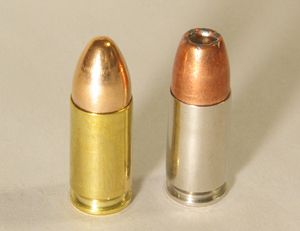A few weeks ago, one of my students asked a great question. She wanted to know which ammunition type she should choose for self defense. "One of my friends said I should use the most dangerous ammunition—hollowpoints. Is that right?"
Yes, I told her. You should use hollowpoints for self defense, assuming they are legal in your state as they are in mine. But contrary to contemporary myth, hollowpoints aren’t the "most dangerous" bullet design for self defense. They’re the safest! That’s why nearly every law enforcement agency in America uses them.
 |
| Left: 9mm Full Metal Jacket — Right: 9mm Hollow Point (Speer Gold Dot) |
First, let’s talk about what a hollowpoint bullet design looks like, and what it does. A traditional bullet used for target shooting typically features a round nose. In fact, that’s one of the common names for that traditional bullet shape: roundnose ammunition. Other bullet shapes designed for target shooting have blunt, squared-off noses. But whether the nose is rounded or flat, all target ammunition has one thing in common: a smooth, unbroken front surface. Not so with hollowpoints! Hollowpoint bullets have a deep dimple in the nose, a hollowed-out area on the front surface. When the hollowpoint bullet strikes a semi-solid object (such as a human body), the dimple allows the bullet to expand, opening up almost like an umbrella or a parachute does. Some hollowpoint bullets are also designed to fragment as they expand.
As the hollowpoint bullet opens up, it makes a larger hole than a roundnose bullet of the same caliber would do. Hollowpoints that fragment produce extra wound channels to cause rapid blood loss. That’s where we get the idea that hollowpoints are more dangerous; each individual bullet does indeed create more damage than an individual roundnose bullet does. However, because each individual shot does more damage, hollowpoints are the safest option for use in self defense. How can this be? Three ways:
1. Because each bullet does more damage, you can stop the attacker more quickly. When the attacker stops quickly, you are less likely to be injured. So hollowpoint bullets are safer for you.
2. Because each bullet does more damage, you will probably need to shoot fewer times to stop the attack. Leaving fewer holes in the attacker makes it more likely that the attacker will survive to go to trial. So hollowpoint bullets are actually safer for the bad guy.
3. The mushrooming or fragmenting activity of the bullet "puts the brakes on" inside the attacker’s body. That creates more damage. But it also makes the bullet far less likely to go through the attacker to strike a bystander or the loved ones you are trying to protect. Because of their shape, hollowpoint bullets that miss their intended target are also less likely to ricochet and hit innocent others. So hollowpoint bullets are safer for bystanders.
Although it seems counterintuitive to choose an ammunition that does more damage in order to produce better outcomes and more safety for everyone involved, that’s what we see when we choose hollowpoint bullets for self defense.



